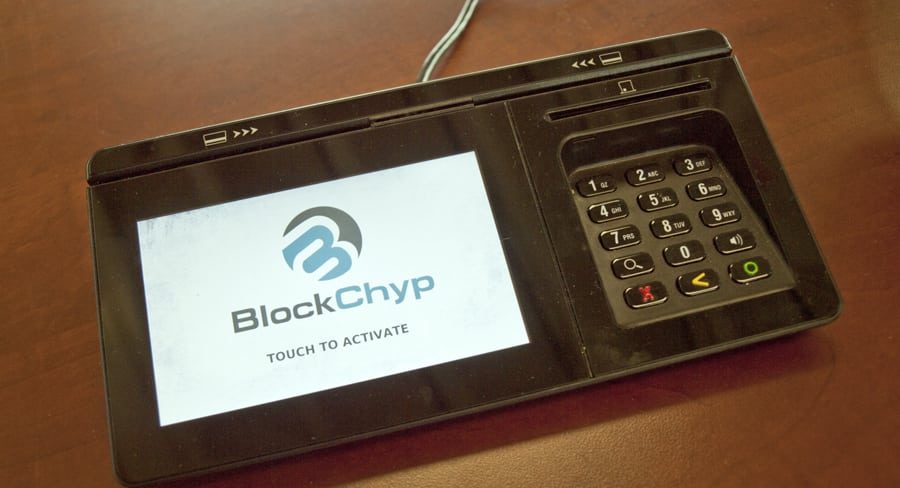
Home » Kennewick startup develops payment transaction solution for small businesses
Kennewick startup develops payment transaction solution for small businesses

September 13, 2018
Small businesses face a lot of challenges. And the least of business owners’ worries should be accepting payments from customers.
In the modern era of chip cards, cryptocurrencies, Apple Pay, and other emerging payment methods, processing transactions can be a tedious and frustrating part of running a business.
That’s where Kennewick’s BlockChyp comes in. The tech startup offers a new kind of payment terminal technology whose easily scalable firmware integrates quickly and seamlessly with third-party point-of-sale, or POS, systems.
Developer Jeffrey Payne and a former co-worker have worked for a combined 30 years in designing POS systems.
“We were fed up and understood what was needed in this marketplace. We knew that we could help software vendors grow their business and offer better payment technology,” Payne said.
Jessra and Jake Rivera, owners of Children’s Attic clothing store in Kennewick, said the existing system doesn’t help small businesses succeed.
“Currently, our point-of-sale system is separate from our credit card terminal. It’s like running two computers at once,” Jessra. “We’ve been sticking with our same old one because it works.”
One of the “woes” of small business, Jessra said, is processing electronic transactions and keeping equipment up to date to accommodate regularly revised compliance guidelines and new payment methods.
It’s not uncommon for small businesses to have multiple devices behind the counter to accommodate customers.
It’s also not uncommon for small business owners to not accept all forms of payment.
This is largely determined by whether a business owner’s industry-specific POS system, such as the one used by secondhand clothing retailers like the Riveras, is compatible with a given payment terminal.
“A lot of companies make you rent, lease or buy equipment and end up charging you more than it’s worth,” Jessra said. “The cost of equipment is high, and we can’t run enough sales to (qualify for new) equipment.”
What to customers appears a simple insertion or swipe of their card involves multiple parties to route and process the money from the customer’s bank to the merchant.
Big box stores like Walmart or Target have a more direct line of communication with the big four credit card companies — Visa, Mastercard, Discover and American Express — and can afford to process their own transactions.
But small businesses are forced to pay a third-party card processor to perform this service. The local representative of the company claims a fee off the top of every transaction, then another percentage goes back to the processing company, and another goes to the routing credit card company whose card was swiped.
Larger corporations can absorb the loss in revenue paid in fees, but small businesses can suffer because, as Jessra explained, they don’t bring in as much money for the credit card companies and processors, but rely on their services to operate, so they are assessed the highest fees.
“The average (amount collected) ends up being about 1.8 percent to over two percent (of each transaction),” Jake said. “And if we’re taking a rewards card, they charge a higher percentage, from two percent up to 4.5 percent.”
Basically, the business is forced to pay the cardholder’s rewards benefits. And no matter what, a portion of the money the customer thought was going to support a local business is actually funneled to their credit card company and other middlemen.
“That’s how it kills small business,” Jake said.
BlockChyp seeks to improve the process.
Rather than rely on hardware and software to do the heavy lifting, routine firmware updates will enable businesses to keep up with industry evolution, without the burden of buying new or additional equipment.
“One device for cryptocurrencies, for gift cards, for loyalty programs, for credit card transactions. The only thing it doesn’t do is cash,” Payne said. “Our goal is to keep it really, really simple.”
BlockChyp also takes a new approach to the decades-old security issues of current, outdated encryption technologies.
BlockChyp is built on a type of advanced blockchain developed by RaiBlocks, commonly referred to as a “block lattice,” which circumvents the big issues facing blockchain technology.
Instead of single ledger on which all transactions are recorded, each merchant and customer has his or her own blockchain, which comprise a system of multiple, parallel blockchains between which transactions occur.
This eliminates the bottleneck created by the energy-intensive, competitive proof of work data mining that plagues single blockchain systems and which led to a recent power moratorium on new data mining operations in Franklin County.
Meanwhile, customer experience at the register remains the same.
When customers insert their cards, a “send” request is sent from the merchant’s blockchain to the customers’. The BlockChyp gateway directly accesses the Electronic Payment Exchange to check the buyers’ available funds through the bank guarantor associated with the customers’ cards.
Once a customer confirms the amount to be charged, an acknowledgement, or ack, is sent to the merchant’s blockchain. Even if the internet connection or link to the exchange is lost temporarily, the transaction can still be completed. It will be recorded and processed later.
BlockChyp’s founders created the “clock chain” and corresponding “tick” blocks to provide a tamper-proof universal time reference for all transactions recorded in the block lattice.
As Payne explained, if you “break the future, you break the past and vice versa, and that’s what makes it tamper-proof,” since only an individual blockchain’s owner can add onto it.
Blockchains have been lauded for their security, while the level of encryption in fraud-prone credit card magnetic strips and chips often falls below modern standards of electronic encryption, according to BlockChyp officials.
They also said “a carefully designed blockchain protocol can leverage modern cryptography to eliminate centralized control from the consumer credit networks and allow card issuing lenders and merchants to interact directly with zero interchange costs.”
BlockChyp does deduct a small fee for processing transactions.
“But no matter how we broke it down, (BlockChyp’s) fee always ends up saving us,” Jake said.
“It will actually make checkouts faster,” Jessra added.
A portion of the fee is given to the POS system provider to encourage more widespread adoption of BlockChyp.
As Payne explained, the more POS providers they can get on board, the more merchants they can reach. “There are 15 million card terminals in the U.S. right now,” Payne said. “Once you (integrate) over a million, the pure blockchain system becomes viable.”
As BlockChyp officials explained, “(A pure) blockchain means credit card associations and their gatekeepers don’t really need to exist. Once we have a large enough critical mass of merchants, we can easily roll out new tech that bypasses the acquirers and card associations entirely, including a pure blockchain consumer credit network.”
Payne said the company could have a million terminals in place within four to five years.
Payne and his partner plan to officially launch the company this December with the help of Martin Olsen, a POS industry veteran and founder of Napa Valley Point of Sale.
“When the BlockChyp team approached me with their vision of streamlining client sign-ups, lower rates, and removing the barriers for PCI compliance, I was very intrigued because it had all the components to help other vendors solve issues which in turn increases their bottom line and improve their customer service,” Olsen said.
This fall, BlockChyp plans to integrate its first POS systems, with the goal of being able to accept Bitcoin currency sometime during second quarter 2019. Children’s Attic hopes to be one of the company’s pilots.
BlockChyp closed its first funding round with a Series AA transaction valuing it at $3.4 million. It used some of the money to open a new Payment Technology Lab in the 1,100-square-foot former offices of FDM Development, next door to Blankspace in Kennewick’s Southridge area.
The new facility will support firmware and gateway development. It also will serve as a pilot terminal fulfillment facility.
“We don’t need it as a workspace necessarily … (but we) have to go through PCI auditing security, and you can’t do that out of your garage,” Payne said.
The company’s chief financial officer lives in the Tri-Cities, and a partner engineer in Dallas, Texas, will be moving soon to work on site. Payne said BlockChyp will be looking to hire more talent in the future.
The sales and marketing arm of the business will remain in Dallas to be managed by other company partners.
“The biggest threat to our long-term goal is the sellout,” Payne said. “We’ve already been approached by a major financial institution about acquisition and we’re not even launched yet.”
He said it is tempting, since he and his business partner’s personal stake in creating the company is to generate enough revenue to support their dream of writing novels. He said their team’s commitment to the long-term vision of the company is what keeps them going.
BlockChyp: 5453 Ridgeline Drive, Suite 160, in Kennewick; 509-590-1945; blockchyp.com.
Local News Science & Technology
KEYWORDS september 2018




